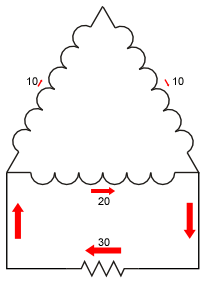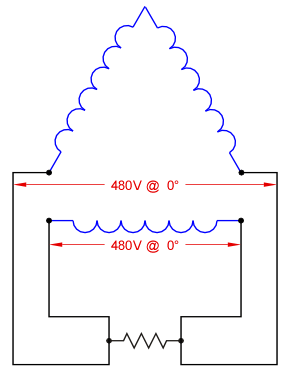You are using an out of date browser. It may not display this or other websites correctly.
You should upgrade or use an alternative browser.
You should upgrade or use an alternative browser.
Ungrounded system
- Thread starter kimrichi
- Start date
- Status
- Not open for further replies.
iceworm
Curmudgeon still using printed IEEE Color Books
- Location
- North of the 65 parallel
- Occupation
- EE (Field - as little design as possible)
In ungrounded system how do we deal with the unbesalanced load betwden phases
So 480V, 1ph loads on a 480V delta - say like 1ph lighting circuits?
Be very uncommon, most loads on un-grounded 3ph are 3ph loads, like heaters or motors.
Still, with the information you have given, say one did hve un-balance loading on a 3ph Delta - what difference would it make? I'd say it is a "so what".
ice
iceworm
Curmudgeon still using printed IEEE Color Books
- Location
- North of the 65 parallel
- Occupation
- EE (Field - as little design as possible)
In ungrounded system how do we deal with the unbesalanced load betwden phases
kim -
thought just occured that you are discussing:
The current on L1 not equal to current L2, not equal to the current on L3. If that is it, the currents don't have to be the same magnitude, but
Summation I = 0
or
L1 + L2 + L3 =0
Don't forget that is a vector calculation.
ice
kwired
Electron manager
- Location
- NE Nebraska
- Occupation
- EC
Same way you would with line - line loads on any other system, connect load so that it is balanced as possible.
Same way you would with line - line loads on any other system, connect load so that it is balanced as possible.
As far as I underxtand when loads are not balanced the neutral will carry tbe difference but here with no neutral?
fmtjfw
Senior Member
- Location
- Fairmont, WV, USA
Picture a triangle with the corners labeled R, S, and T.
If you have a load
between R and S of 10 Amps,
between S and T of 20 Amps,
and
between T and R of 30 Amps,
the current in R is the vector sum of 10 and 30,
the current in S is the vector sum of 10 and 20,
the current in T is the vector sum of 20 and 30.
So when you get around the triangle the "balancing" goes on the the hot wires.
If you have a load
between R and S of 10 Amps,
between S and T of 20 Amps,
and
between T and R of 30 Amps,
the current in R is the vector sum of 10 and 30,
the current in S is the vector sum of 10 and 20,
the current in T is the vector sum of 20 and 30.
So when you get around the triangle the "balancing" goes on the the hot wires.
mivey
Senior Member
as others have said: there is no net unbalance. The other two phases pick up the "slack" of the one or vice-versa.As far as I underxtand when loads are not balanced the neutral will carry tbe difference but here with no neutral?
kwired
Electron manager
- Location
- NE Nebraska
- Occupation
- EC
As far as I underxtand when loads are not balanced the neutral will carry tbe difference but here with no neutral?
On a system with a neutral conductor, the neutral carries unbalanced current from your line to neutral loads, but if you have no line to neutral loads how is the neutral going to carry any current?
If you have a lot of single phase load but none of it is line to neutral, the neutral has no current on it, and the same loads would still draw same current and any unbalance would be same even if connected to a system with no neutral.
...any unbalance would be same even if connected to a system with a neutral.On a system with a neutral conductor, the neutral carries unbalanced current from your line to neutral loads, but if you have no line to neutral loads how is the neutral going to carry any current?
If you have a lot of single phase load but none of it is line to neutral, the neutral has no current on it, and the same loads would still draw same current and any unbalance would be same even if connected to a system with no neutral.
A delta-configured secondary is also more tolerant of imbalance. Attached image depicts how the current of one single-phase load's current is handled by the three secondary windings. I used only one single phase load because the vector sum for three imbalanced single-phase loads isn't quite as obvious...As far as I underxtand when loads are not balanced the neutral will carry tbe difference but here with no neutral?

kwired
Electron manager
- Location
- NE Nebraska
- Occupation
- EC
...any unbalance would be same even if connected to a system with a neutral.
Thanks, I think:blink:
mivey
Senior Member
He was just closing the loop. On the second lap.Thanks, I think:blink:
zog
Senior Member
- Location
- Charlotte, NC
So 480V, 1ph loads on a 480V delta - say like 1ph lighting circuits?
Be very uncommon, most loads on un-grounded 3ph are 3ph loads, like heaters or motors.
Still, with the information you have given, say one did hve un-balance loading on a 3ph Delta - what difference would it make? I'd say it is a "so what".
ice
Many breakers will actually look at phase currents and compare them to sense ground faults (Unless you have a 4 wire system with a external nuetral CT) so this can cause nuisance trips, pretty common issue.
BPoindexter
Inactive, Email Never Verified
- Location
- MT Vernon, WA
A delta-configured secondary is also more tolerant of imbalance. Attached image depicts how the current of one single-phase load's current is handled by the three secondary windings. I used only one single phase load because the vector sum for three imbalanced single-phase loads isn't quite as obvious...

Shouldn't the values be 17.3A, 6.35A, 6.35A? Phase vs Line current?
mivey
Senior Member
No.Shouldn't the values be 17.3A, 6.35A, 6.35A? Phase vs Line current?
Look at it as two parallel power sources. Both have the same voltage and phase. The only difference is the impedance of the source...Shouldn't the values be 17.3A, 6.35A, 6.35A? Phase vs Line current?

- Status
- Not open for further replies.

